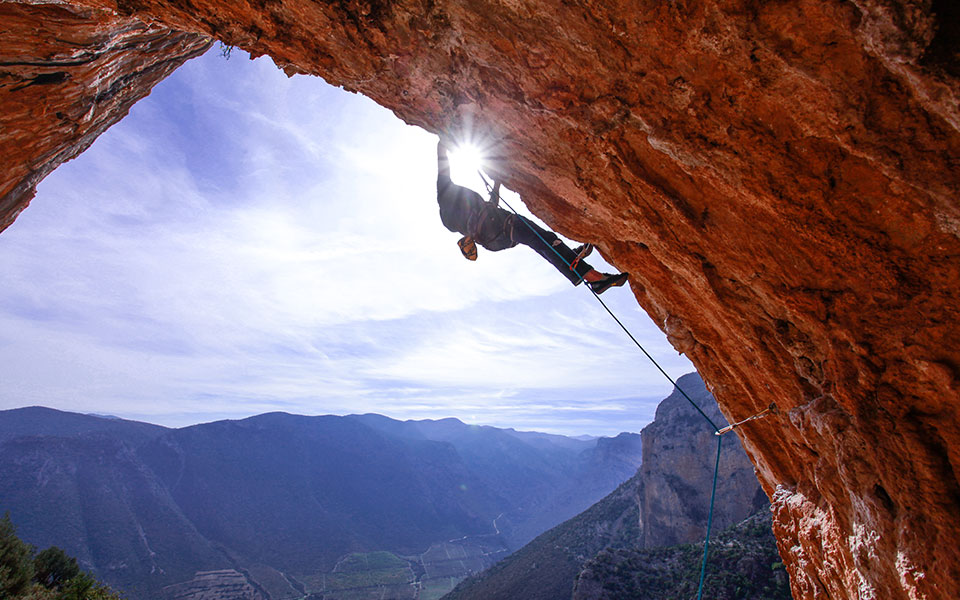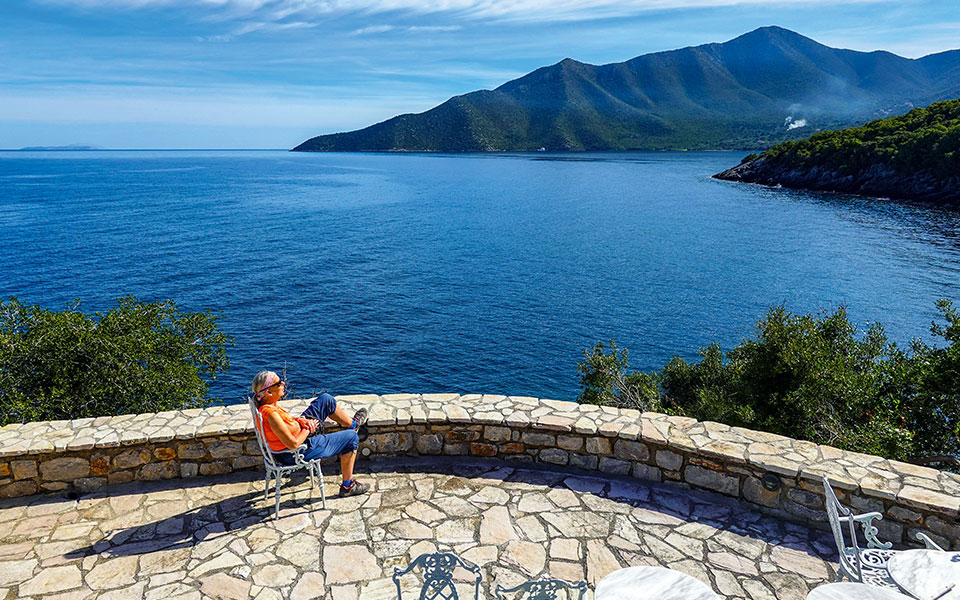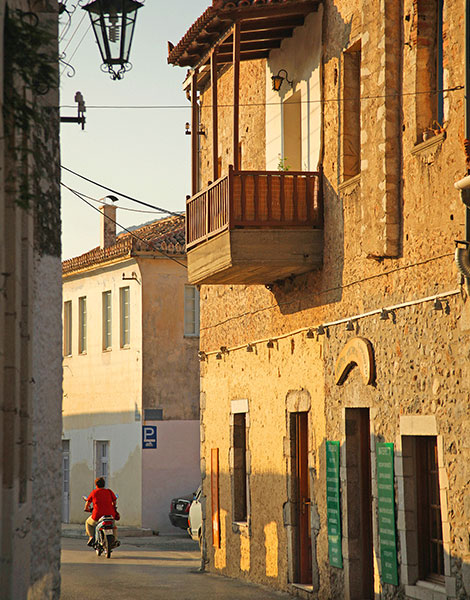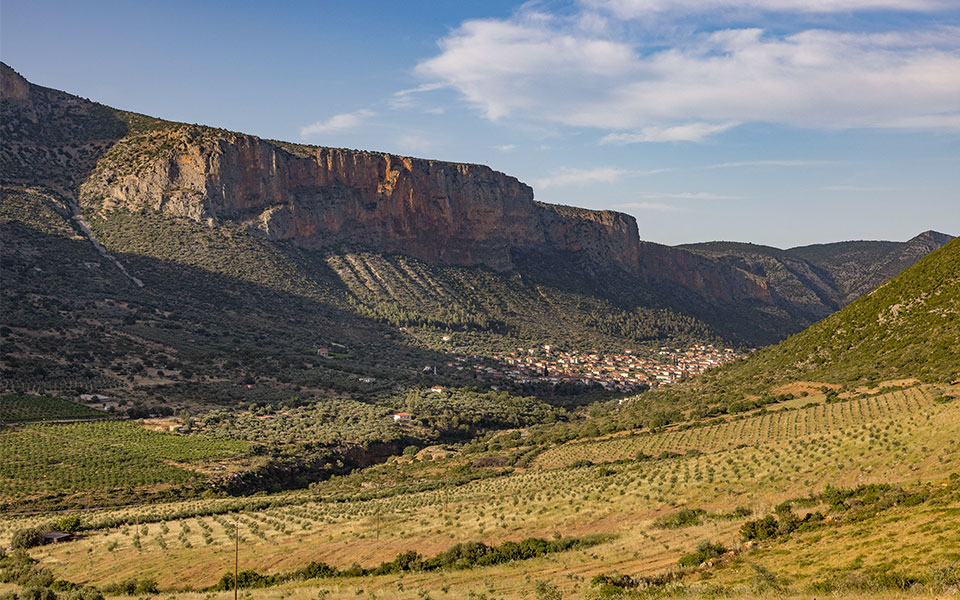The Best Archaeological Day Trips from Nafplio
From Mycenaean citadels to ancient stadiums,...

Leonidio has become one of the best-known climbing destinations in the world.
© Babis Giritziotis
Sun, sea, wild flowers in bloom, well-tended yards and a beautiful small town. Leonidio is an ideal destination for spring outings, especially at Easter, when the capital of the Tsakonia region honors one of the most famous Greek customs, that of hot-air balloons.
More than 1,000 balloons are released into the Easter sky on the night of the Resurrection, making for a delightful spectacle, in a custom that is said to have been brought back from the Far East by local sailors. Their construction begins in February with the cutting of the reeds that will be used. Then, sheets of paper, usually red or orange, must be carefully glued to the reed framework. The number of sheets depends on the size of the balloon, roughly 16 for the smaller ones and about 34 for the larger versions. The work requires a degree of skill, but in Leonidio they learn from an early age! Even the elementary school devotes one day to balloon construction and the local kids traditionally fly their creations on the Friday night before Lazarus Sunday. In addition, one group of youngsters has established a tradition of flying their own massive balloon from the Fabrica of Culture building at 22.30 on Holy Saturday, and it always carries a message.
On the same night, the moment it is heard that “Christ Has Risen” from the town’s five churches, pieces of cloth suspended below the “envelopes” are drenched in oil and petrol, set alight and – with the deftest of movements – the balloons are released by the parishioners into the night sky. Fireworks and bell ringing contribute further to the festive atmosphere.

Sun and sea: the ultimate springtime setting at Poulithra, a traditional village 7km southeast of Leonidio.
© Visualhellas.gr
On Good Friday, the Epitaphios – a large embroidered cloth bearing an image of the dead body of Christ – is taken out of each of the five churches at 22.00 and carried through the streets in solemn procession. The adornment of this major religious icon, often with white and purple violas, had already begun on Holy Wednesday. The scene is quite amazing, with small lanterns made from bitter oranges having been placed along all the streets. Lovingly made by volunteers one month in advance, they are lit that night with a tiny candle placed inside.
On Easter Sunday, at about 11.00, the municipality puts on a feast in the Town Hall garden, with spit-roasted meat, wine and other treats. In the afternoon, during the Agape Service in 25 March Square, the Gospel is read also in the Tsakonian dialect. It is not long before a celebration is in full swing as men wearing fustanella kilts and women dressed in the traditional costume of the village of Prastos perform the time-honored Tsakonian dance to live music. More hot-air balloons are released, this time by visitors under the guidance of locals.

Take a stroll through Leonidio, with its atmospheric streets and old houses.
© Visualhellas.gr

The Easter hot-air balloons of Leonidio are one of Greece’s most spectacular customs.
© Giorgos Tsafos
You will certainly enjoy getting out and about in Leonidio, where the gaze generally travels upwards to the Kokkinovrachos, the imposing Red Rock at the “back” of the town. As you walk around, you will see old mansions, eye-catching gates and courtyards full of flowers, but save some time for the main street with its tavernas and shops. You can also stroll along the river, where you will find the Fabrica of Culture, a cultural multi-venue with a fascinating exhibition about the region, with themes ranging from history and architecture or the intriguing Tsakonian dance, to local products such as the celebrated Tsakonian eggplant. The Tsouchlos Mansion houses the Tsakonian Archive (Tel. (+30) 6937.898.030).
Apart from viewing the inside of one of these mansions, you will also see the art of Tsakonian weaving being taught, as well as lessons in the Tsakonian dialect, which the local people are making every effort to preserve. Indeed, teacher and author Eleni Manou, who hails from Leonidio, has self-published four books: two children’s fairytales in Tsakonika and modern Greek, one Tsakonika dictionary and a book of Tsakonian cooking. She also gives lessons in Tsakonian cuisine at your accommodation ([email protected]).

The seasonal river of the Dafnon Valley flows through Leonidio and into the sea.
© AFP/Visualhellas.gr
If you’re looking for more action, well it’s good to know that Leonidio is a paradise for climbers, and this time of year in particular (thanks to mild temperatures) is ideal for this sport. The Arcadian town found itself well and truly on the climbing map in 2013 when successive routes were opened. With more than 65 sectors and over 2,000 routes covering all degrees of difficulty, many climbers from all over the world pay a visit at some point in the year, even during the winter, though not so much in summer because of the high temperature.
But that’s not all. You can also enjoy excursions in the surrounding area. Kryoneri, Plaka, Poulithra, Sampatiki, Tyros – the entire coastline is wonderful for your first dips of the year and perhaps a glass of ouzo beside the water. If you prefer the mountains, follow the marvelous route through the towering rocks of the imposing Dafnon Gorge as far as the Monastery of Panagia Elona, which can be traced back to 1300 and whose church dates to 1809. If you don’t mind the twists and turns, continue along the forested slopes of Mt. Parnon till you reach the charming village of Kosmas, with its view of the Myrtoan Sea.
Archontiko Hatzipanayiotis (Tel. (+30) 27570.224.76, from €65 with breakfast). The historic mansion of the Hatzipanayiotis shipping family, restored with respect and good taste, preserving all the authentic architectural features of its time. Domes, arches, chagiatia (roofed, balcony-like floor extensions) and stone archways in the garden with its high walls and pebble paving, painted ceilings, exposed stone, wooden beams and staircases in the interior. The guest rooms have a romantic, relaxing atmosphere, and offer branded cosmetics and linen. While in addition to wellness facilities and services, there is an inviting Café-Bistro open also to non-guests.
Archontiko Chioti (Tel. (+30) 27570.223.32, from €78 with breakfast). Completed in 1864, this beautiful mansion has been lovingly restored and turned into a boutique hotel with warm spaces adorned with antique furniture. Some rooms still retain their domes and elaborate ceilings, while others afford a view of the Red Rock through the skylight. A bar, outdoor pool and wellness facilities with spa services are all available.
Agroktima Traditional Guesthouse (Tel. (+30) 27570.232.44, from €80 with breakfast). Ten stone residences with fireplaces, on the road to Plaka. The family owns land where it cultivates fruit trees and raises chickens. Their eggs, along with oranges from the orchards, are the mainstay of breakfast, which will be hanging in a basket outside your door each morning.
In the seaside village of Poulithra, you will find the Byzantinon Hotel (Tel. (+30) 27570.512.20, from €78 with breakfast) with 11 studios and apartments, all with fully equipped kitchen, balcony or veranda and a view of the olive trees and sea, as well as Smyros Resort (Tel. (+30) 27570.512.00, €90 with breakfast) with rooms, suites, restaurant, pool, and sea views.
If you prefer the mountains, head up to the village of Kosmas and the Ouranogiton Guesthouse (Tel. (+30) 27570.314.90, from €80 with breakfast), offering well looked after rooms with a fireplace and mountain view.
In Leonidio, because of the climbers, there are numerous independent houses and apartments available for rent, but also villas worth a special mention. Check out Dios Guesthouses after Petra (Tel. (+30) 27570.415.08, from €75 with minimum stay of two nights), and Kissakas overlooking Livadi beach (Tel. (+30) 6944.391.966, from €200 for 4+2 persons).
From Mycenaean citadels to ancient stadiums,...
From ancient healing sanctuaries to legendary...
A historic hotel redefines modern Greek...
Just two and a half hours...